Chili is not just a comfort food; it is also a nutritious meal that can support your health goals, especially if it’s high protein chili!
High protein chili is an easy and excellent option for those looking to increase their protein intake without compromising on flavor. By including ingredients like ground beef, turkey, beans, lentils, and vegetables, you can create a filling and tasty dish.
You don’t need to be a cooking expert to make a delicious high protein chili. With simple ingredients and easy steps, you can prepare a meal that is both hearty and protein-packed.
High protein chili is also versatile, allowing you to experiment with different ingredients and cooking methods. Whether you prefer using a slow cooker for convenience, or cooking on the stove top for a quick meal, this dish can fit into any schedule.
Table of Contents:
- Nutritional Breakdown of High Protein Chili
- Choosing Ingredients for Your High Protein Chili
- Cooking Techniques: Stove-top vs Slow Cooker
- Toppings and Customizations
- Storing Your High Protein Chili
- High Protein Chili Conclusion
- Additional High Protein Resources
Nutritional Breakdown of High Protein Chili
High protein chili is a nutritious meal that includes proteins, carbs, fiber, and fats. All of these, combined, make a truly delicious and nutritious meal!
Understanding Protein in Chili
Protein is, understandably, a key component in high protein chili. It mainly comes from the meat and beans included in the recipe. Beans like kidney beans and black beans contribute significantly to the protein content.
A single serving can provide about 25–50 grams of protein, depending on the portion size and specific ingredients used.
Role of Fiber and Complex Carbs
Beans are also rich in fiber, making high protein chili a great source of this nutrient. Kidney beans and black beans not only add protein but also provide dietary fiber, which helps with digestion and maintaining blood sugar levels.
Fiber is essential for a healthy diet, and one serving of high protein chili can offer about 7–15 grams of fiber, depending on the amount and type of beans used.
Additionally, complex carbs in chili, particularly those found in beans, break down slowly, providing sustained energy.
Saturated Fat vs Unsaturated Fat
Chili contains fats that come mostly from the meat (usually, beef or turkey) and any added oils. Using lean ground beef helps to reduce the overall saturated fat content of your chili.
Olive oil and other vegetable oils used when making chili can provide unsaturated fats, which are healthier for the heart.
It’s important to balance fat intake by minimizing saturated fats while incorporating unsaturated fats. Typically, a serving of high protein chili has about 10–20 grams of fat, with a healthy ratio of saturated to unsaturated fats for balanced nutrition.
Choosing Ingredients for Your High Protein Chili
When making high protein chili, picking the right ingredients is key. Your choices will impact the flavor, texture, and nutritional value of your dish. Below, we’ve compiled some tips on selecting proteins, vegetables, and spices to create the best chili. Yum!

Choosing Your Protein Base
The protein base is the heart of your chili. Common options include ground beef, turkey, or chicken. Beef is rich in flavor and hearty, making it a popular choice.
If you prefer a leaner option, turkey or chicken also work well. For a vegetarian alternative, consider using kidney beans, black beans, or chickpeas. These options are high in protein and fiber, which can contribute to a delicious and filling meal.
When cooking your meat, start by heating a bit of olive oil in a pot. Add the meat and break it into small, even crumbles until it’s browned and cooked through.
For beans, rinse and drain them before adding them to your chili. Combining different protein sources can also be an excellent way to boost the overall protein content of your chili.
Vegetables
Vegetables add essential nutrients and layers of flavor to your chili. Onions and garlic are great choices as they add depth (and smell delicious).
Start with onion; chop it finely and sauté in olive oil until it’s softened. Add minced garlic shortly after the onion becomes translucent.
Bell peppers are another classic addition. They come in various colors like red, green, orange, and yellow, each adding a slightly different flavor.
Cut them into small pieces and cook them with your onions and garlic. If you like a bit of heat, try adding chopped jalapeños or another type of chili pepper can be a good idea. Cook until all the vegetables are soft and well-incorporated.
Herbs and Spices
Herbs and spices are what give your chili its distinctive flavor! Common spices include cumin, chili powder, and cayenne pepper. Cumin adds a warm, earthy flavor, while chili powder brings a mild heat and rich color. Cayenne pepper can be added for an even more intense kick!
And, don’t forget to season with salt and pepper to taste. Fresh or dried herbs like oregano and parsley can also be delicious additions.
Cooking Techniques: Stove-top vs Slow Cooker
There are multiple ways to cook high protein chili, including using a stove top or a slow cooker. Each method has its own steps and tips to ensure the best flavor and texture. Simmering is also an important technique for achieving a rich and tasty chili.
Stove-top Method
Using a stove top, you can cook chili quickly while maintaining control over the heat and ingredients. Start by heating a large pot over medium-high heat. Add olive oil and then your choice of ground meat, breaking it up into small pieces as it browns.
Once the meat is browned, remove it and set aside.
Next, in the same pot, add onions, bell peppers, and any other vegetables you’d like. Sauté for about 5 minutes, or until they soften. Add minced garlic and cook for another minute.
Return the beef to the pot along with tomatoes, beans, spices, and any other flavorings you’d like to add. Bring to a boil and then lower the heat to a simmer. Cover and cook for 30–45 minutes, stirring occasionally to prevent sticking.
Slow Cooker Method
A slow cooker is a convenient way to make chili with minimal effort. Begin by browning the ground beef on the stove top in a skillet. This step enhances flavor but can be skipped if you’re short on time. Transfer the browned beef to your slow cooker.
Add chopped onions, bell peppers, and minced garlic to the slow cooker. Pour in canned tomatoes, tomato sauce, beans, spices, and any other ingredients you’d like. Stir everything well before putting the lid on.
Cook on low for 6–8 hours, or on high for 3–4 hours. Adjust the thickness by adding more broth if needed.
Toppings and Customizations
Choosing the right toppings can enhance your high-protein chili. Customizations allow you to adapt the recipe for various dietary needs without sacrificing flavor.
Best High Protein Chili Toppings
Adding toppings can boost the protein content and add extra flavors and textures to your chili. Shredded cheese is a popular choice that melts great over hot chili. If you prefer a non-dairy option, dairy-free cheese can be a good substitute.
Greek yogurt is another fantastic topping that not only adds creaminess but also more protein. Sour cream is a classic, and for a lighter option, try low-fat Greek yogurt.
For a smoky crunch, bacon bits work well. Adding cooked shredded chicken or chorizo increases both the protein and the flavor profile. Chopped hot dogs can also add a fun twist.

Customizing for Dietary Restrictions
To reduce sodium intake, you can control the salt content by using low-sodium canned beans (or rinse regular canned beans), and tomatoes, and seasoning with fresh herbs and spices.
For a gluten-free option, ensure that all added ingredients, like spice mixes and toppings, are certified gluten-free.
Vegans can replace meat with plant-based proteins like lentils or tofu, which can absorb the chili flavors and add protein.
Always read labels to confirm products are safe for your dietary needs.
Storing Your High Protein Chili
Storing your high protein chili correctly ensures it stays fresh and safe to eat. Allow the chili to cool before transferring it to airtight containers. This helps to prevent condensation and bacterial growth.
In the refrigerator, chili can last for up to 3–4 days. For longer storage, consider freezing it. Place portions in freezer-safe bags or containers, leaving some space for expansion. Frozen chili can last up to 3 months.
When reheating, make sure the chili reaches an internal temperature of 165°F to kill any potential bacteria.
To make meal prep easier, label containers with dates so you know how long they’ve been stored. This ensures you’re always eating fresh chili, and can minimize food waste.
High Protein Chili Conclusion
High protein chili can be a delicious and nutritious addition to your diet.
With ingredients like lean beef, beans, and vegetables, you get a balanced meal that’s high in protein and fiber.
You can easily adapt recipes to suit your taste. Try adding different spices, vegetables, and toppings. Don’t forget to customize your toppings for extra flavor. Avocado, cheese, or even a dollop of Greek yogurt can be great options.
For a thicker chili, adjust the amount of broth or let it simmer longer.
Try this high protein chili to enjoy a tasty and satisfying meal!
Additional High Protein Resources
- High Calorie Soups for Weight Gain
- High Protein Vegan Recipes
- Easy High Protein Vegan Breakfast Ideas
- Vegan Protein Sources Chart [Free Download]
- High Calorie High Protein Diet Ideas + Recipes
- Easy High Protein Lunch Ideas
- 7 Delicious Protein Smoothies for Weight Gain
- 31 Healthy Protein Powder Recipes [Dietitian Approved]
- The Geriatric Dietitian’s High Protein Archive

Thank you so much for all this valuable information!